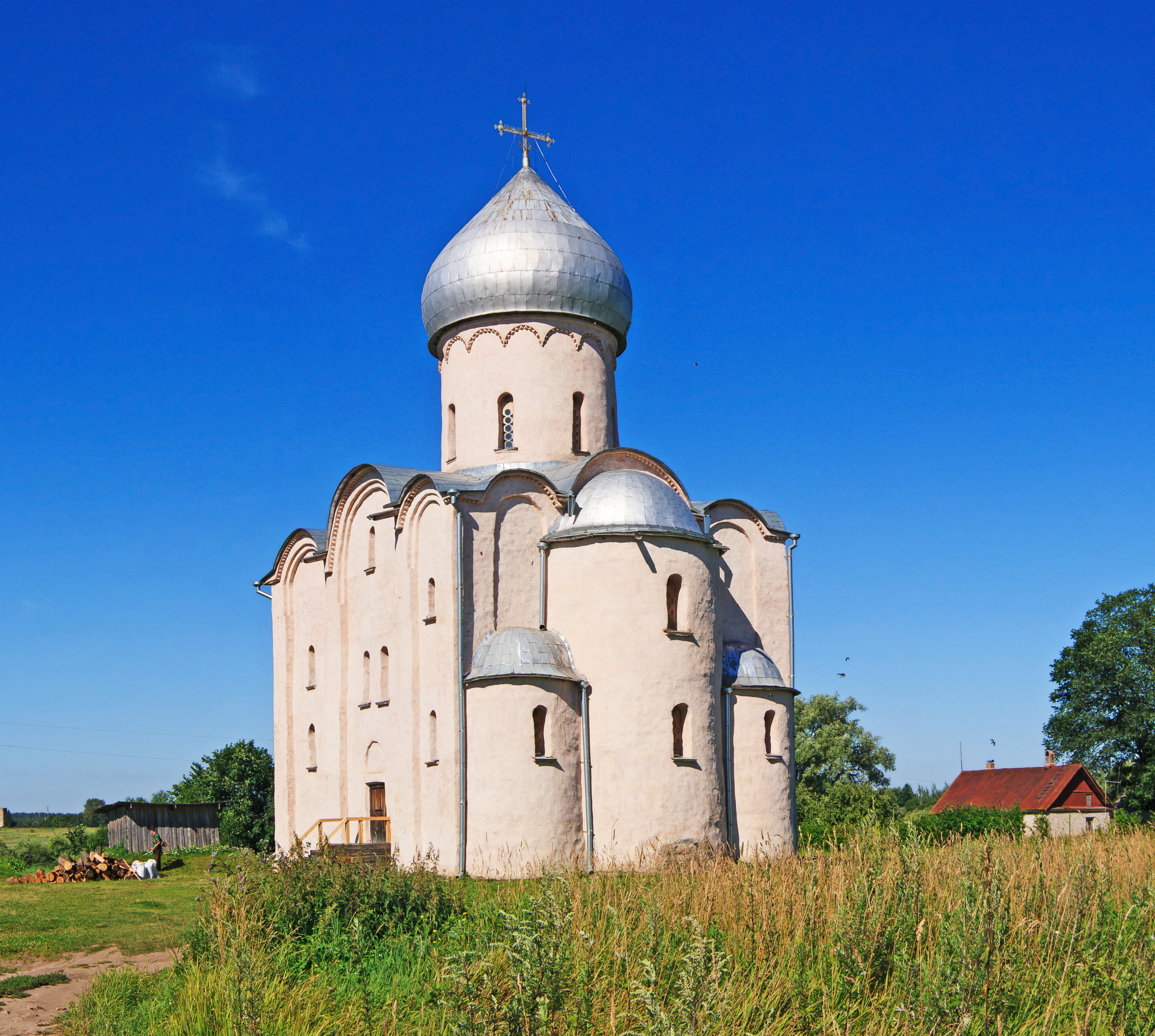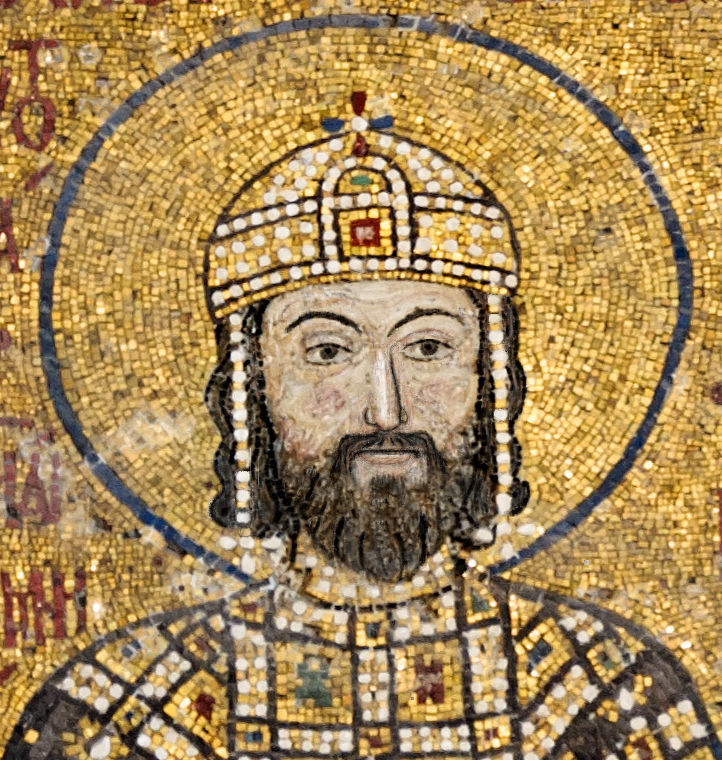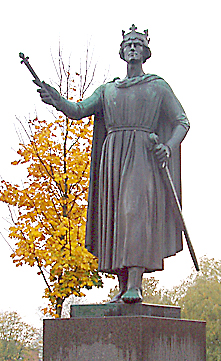|
Christina Ingesdotter Of Sweden
Princess Christina Ingesdotter of Sweden (Swedish language, Swedish: ''Kristina Ingesdotter'') (11th century – 18 January 1122) was a Swedish princess and a princess consort of Veliky Novgorod, Rostov and Belgorod, by marriage to Grand Prince Mstislav I of Kiev. Life Christina was the daughter of King Inge the Elder of Sweden and Helena, Queen of Sweden, Queen Helena. Helena was the sister of Blot-Sven King of Sweden. She was likely the eldest of the three royal daughters, being married before her sisters Margaret and Catherine. Christina was married to Mstislav I of Kiev, Mstislav, who was Prince of Veliky Novgorod, Rostov, and Belgorod during their marriage, thereby giving her the equivalent titles. According to Vasily Tatishchev they married in 1095. Polish historian Dariusz Dąbrowski stated that Tatischev didn't base on reliable source. Christina married Mstislav between 1090 and 1096. The personal seal of Christina has been found by archaeologists, depicting a woman with ... [...More Info...] [...Related Items...] OR: [Wikipedia] [Google] [Baidu] |
House Of Stenkil
The House of Stenkil was a dynasty on the Sweden, Swedish throne from c. 1060 to c. 1125. Stenkil probably originated from Västergötland. Line (of magnates and earls) before Stenkil, according to the Norse sagas: *Skagul Toste (took Danegeld in England and was the father of Sigrid the Haughty) *Ulf Tostesson, the son of Skagul Toste *Ragnvald Ulfsson, the son of Ulf Tostesson, and exiled to Staraja Ladoga by Olof Skötkonung On the throne of Sweden or Västergötland: *1060–1066 : Stenkil *1067–1070 : Halsten Stenkilsson (''Halsten''), son of Stenkil *1079–1084 : Inge I of Sweden, Inge the Elder (''Inge den äldre''), son of Stenkil *1084–1087 : Blot-Sweyn (''Blot-Sven''), possibly brother-in-law of Inge I of Sweden, Inge I the Elder *1087–1110 : Inge I of Sweden, Inge the Elder (''Inge den äldre''), 2nd time, restored *1110–1118 : Philip of Sweden, Philip (''Filip Halstensson''), no children *1110–1125 : Inge II of Sweden, Inge the Younger (''Inge den yngre''), ... [...More Info...] [...Related Items...] OR: [Wikipedia] [Google] [Baidu] |
Nereditsa Church
The Saviour Church on Nereditsa Hill near Novgorod (russian: церковь Спаса на Нередице, ''Tserkov Spasa na Nereditse'') is a 12th-century Orthodox church dedicated to the feast of the Saviour's Transfiguration. The church, consecrated in 1198, became world-famous both for its remarkable state of exterior preservation and for the best preserved set of pre-Mongol wall paintings in the Russian Empire. During the World War II it was selected as a target for artillery fire and was reduced to rubble. The post-war reconstruction of the Nereditsa Church is on the World Heritage list as a part of object 604 Historic Monuments of Novgorod and Surroundings. The building has been designated an architectural monument of federal significance (#5310113002). It is located in Novgorodsky District of Novgorod Oblast, Russia, south of Veliky Novgorod in the village of on the right bank of the Maly Volkhovets River on a small Nereditsa Hill next to the Rurik hillfort. H ... [...More Info...] [...Related Items...] OR: [Wikipedia] [Google] [Baidu] |
Vsevolod II Of Kiev
Vsevolod II Olgovich (Cyrillic: Всеволод II Ольгович) (died August 1, 1146) was the Prince (Knyaz) of Chernigov (1127–1139) and Grand Prince of Kiev (Velikiy Knyaz), 1139–1146), son of Oleg Svyatoslavich, Prince of Chernigov. Vsevolod married Maria Mstislavna of Kiev, the daughter of Grand Duke Mstislav of Kiev. They had two sons and two daughters: # Sviatoslav III of Kiev # Yaroslav II Vsevolodovich Yaroslav II Vsevolodovich (Kiev, 1139–1198) was a Rus’ prince (a member of the Rurik dynasty). He was prince of Ropesk (c. 1146–1166), of Starodub (1166–1176), and of Chernigov (1176–1198). His early life He was the second son of princ ..., born in 1139 # Anna of Chernigov, married a prince of Halych, son of Vasylko Rostyslavych according to some chronicles # Zvenislava of Chernigov, married Boleslaw I the Tall, Duke of Wroclaw Though he had two sons, Vsevolod's chosen successor was his brother, Igor, and he obtained pledges from his subjects to ... [...More Info...] [...Related Items...] OR: [Wikipedia] [Google] [Baidu] |
Maria Mstislavna Of Kiev
Maria Mstislavna of Kiev (died 1179), was a Grand Princess consort of Kiev by marriage to Prince Vsevolod II of Kiev. She was the daughter of Mstislav I of Kiev and Christina Ingesdotter of Sweden. Her marriage was arranged in 1116 to facilitate better relations between her father and spouse, who were long standing enemies. During the reign of her spouse, she was known for her diplomatic ability, and often asked to mediate between her husband and brothers. She is believed to be one of the founders of St. Cyril's Monastery. Issue # Sviatoslav III of Kiev # Yaroslav II Vsevolodovich, born in 1139 # Anna of Chernigov, married a prince of Halych, son of Vasylko Rostyslavych Vasylko Rostyslavych, ''Vasilko Rostislavich'' (, born around 1066, died in 1124) was a Rus' prince and member of the Rurik dynasty. He was the first Prince of Terebovl' from 1092. His Byzantine-style blinding was very unusual among the Rurik ... according to some chronicles # Zvenislava of Chernigov, marrie ... [...More Info...] [...Related Items...] OR: [Wikipedia] [Google] [Baidu] |
John II Comnenus
John II Komnenos or Comnenus ( gr, Ἱωάννης ὁ Κομνηνός, Iōannēs ho Komnēnos; 13 September 1087 – 8 April 1143) was List of Byzantine emperors, Byzantine emperor from 1118 to 1143. Also known as "John the Beautiful" or "John the Good" (), he was the eldest son of Emperor Alexios I Komnenos and Irene Doukaina and the second emperor to rule during the Byzantine Empire under the Komnenos dynasty, Komnenian restoration of the Byzantine Empire. As he was born to a reigning emperor, he had the status of a . John was a pious and dedicated monarch who was determined to undo the damage his empire had suffered following the Battle of Manzikert, half a century earlier. John has been assessed as the greatest of the Komnenian emperors. In the course of the quarter-century of his reign, John made alliances with the Holy Roman Empire in the west, decisively defeated the Pechenegs, Hungarians and Serbs in the Balkans, and personally led numerous campaigns aga ... [...More Info...] [...Related Items...] OR: [Wikipedia] [Google] [Baidu] |
Alexios Komnenos (d
Alexios I Komnenos ( grc-gre, Ἀλέξιος Κομνηνός, 1057 – 15 August 1118; Latinized Alexius I Comnenus) was Byzantine emperor from 1081 to 1118. Although he was not the first emperor of the Komnenian dynasty, it was during his reign that the Komnenos family came to full power and initiated a hereditary succession to the throne. Inheriting a collapsing empire and faced with constant warfare during his reign against both the Seljuq Turks in Asia Minor and the Normans in the western Balkans, Alexios was able to curb the Byzantine decline and begin the military, financial, and territorial recovery known as the Komnenian restoration. His appeals to Western Europe for help against the Turks was the catalyst that sparked the First Crusade. Biography Alexios was the son of John Komnenos and Anna Dalassene,Kazhdan 1991, p. 63 and the nephew of Isaac I Komnenos (emperor 1057–1059). Alexios' father declined the throne on the abdication of Isaac, who was thu ... [...More Info...] [...Related Items...] OR: [Wikipedia] [Google] [Baidu] |
Dobrodeia Of Kiev
Dobrodeia of Kiev (died 16 November 1131), was a Rus' princess, spouse of the Byzantine co-emperor Alexios Komnenos, and author on medicine. Life Born in Kyiv in the early years of the 12th century, Dobrodeia was the daughter of Mstislav I of Kiev and Christina Ingesdotter of Sweden. In or shortly after 1122, she married Alexios Komnenos, the eldest son and co-emperor of Byzantine emperor John II Komnenos (). She received the title of empress ('' basilissa''), and the name of Irene, after her mother-in-law, Empress Irene of Hungary. She and Alexios had one daughter, Maria, who was born . In the imperial court of Constantinople, she became a part of a circle of women intellectuals, notably Alexios' aunt Anna Comnena, and the noblewoman Irene, known as a patron of astrologers and scholars. She was encouraged to find her own scholarly interest, studied extensively and was described by contemporaries: "She was not born in Athens, but she learned all the wisdom of the Greeks". The wr ... [...More Info...] [...Related Items...] OR: [Wikipedia] [Google] [Baidu] |
Eric II Of Denmark
Eric II the Memorable ( da, Erik II Emune; – 18 September 1137) was king of Denmark between 1134 and 1137. Eric was an illegitimate son of Eric I of Denmark, who ruled Denmark from 1095 to 1103. Eric the Memorable rebelled against his uncle Niels of Denmark, and was declared king in 1134. He punished his adversaries severely, and rewarded his supporters handsomely. He was killed by a subject in 1137 and was promptly succeeded by his nephew Eric III of Denmark. Early life Eric was born around 1090, to King Eric I of Denmark and an unknown concubine.Stefan PajungErik Emune ca. 1090–1137 danmarkshistorien.dk, Aarhus University, 20 January 2010 He was given some Danish isles by his half-brother Canute Lavard, Bricka, Carl Frederik, ''Dansk Biografisk Lexikon'', vol. IV lemens – Eynden 1890pp.540–542 and was ''jarl'' of Møn, Lolland, and Falster.Palle Birk Hansen Jubilæumslogo > Logohistorier > Peder Bodilsen">Forside > Jubilæumslogo > Logohistorier > Peder Bodilsen, N ... [...More Info...] [...Related Items...] OR: [Wikipedia] [Google] [Baidu] |
Sigurd I Of Norway
Sigurd Magnusson (1089 – 26 March 1130), also known as Sigurd the Crusader (Old Norse: ''Sigurðr Jórsalafari'', Norwegian: ''Sigurd Jorsalfar''), was King of Norway (being Sigurd I) from 1103 to 1130. His rule, together with his half-brother Øystein (until Øystein died in 1123), has been regarded by historians as a golden age for the medieval Kingdom of Norway. He is otherwise famous for leading the Norwegian Crusade (1107–1110), earning the eponym "the Crusader", and was the first European king to personally participate in a crusade.Literally "Jerusalem-farer", but commonly translated into English as "the Crusader". Early life Sigurd was one of the three sons of King Magnus III, the other two being Øystein and Olaf. They were all illegitimate sons of the king with different mothers. To avoid feuds or war, the three half-brothers co-ruled the kingdom from 1103. Sigurd ruled alone after Olaf died in 1115 and Øystein in 1123. Before being proclaimed King of Norway, Sig ... [...More Info...] [...Related Items...] OR: [Wikipedia] [Google] [Baidu] |
Valdemar I Of Denmark
Valdemar I (14 January 1131 – 12 May 1182), also known as Valdemar the Great ( da, Valdemar den Store), was King of Denmark from 1154 until his death in 1182. The reign of King Valdemar I saw the rise of Denmark, which reached its medieval zenith under his son King Valdemar II. Childhood Valdemar was the son of Canute Lavard, Duke of Schleswig, the chivalrous and popular eldest son of King Eric I of Denmark. Valdemar's father was murdered by King Magnus I of Sweden days before the birth of Valdemar; his mother, Ingeborg of Kiev, daughter of Grand Prince Mstislav I of Kiev and Christina Ingesdotter of Sweden, named him after her grandfather, Grand Prince Vladimir Monomakh of Kiev. Valdemar was raised at Ringsted in the court of Danish nobleman Asser Rig of Fjenneslev (c. 1080–1151). Asser was a member of the Hvide noble family and had been raised together with Valdemar's father Canute Lavard. Valdemar was raised together with Asser's sons, including Absalon (c. 1128–120 ... [...More Info...] [...Related Items...] OR: [Wikipedia] [Google] [Baidu] |
Schleswig
The Duchy of Schleswig ( da, Hertugdømmet Slesvig; german: Herzogtum Schleswig; nds, Hartogdom Sleswig; frr, Härtochduum Slaswik) was a duchy in Southern Jutland () covering the area between about 60 km (35 miles) north and 70 km (45 mi) south of the current border between Germany and Denmark. The territory has been divided between the two countries since 1920, with Northern Schleswig in Denmark and Southern Schleswig in Germany. The region is also called Sleswick in English. Unlike Holstein and Lauenburg, Schleswig was never a part of the German Confederation. Schleswig was instead a fief of Denmark, and its inhabitants spoke Danish, German, and North Frisian. Both Danish and German National Liberals wanted Schleswig to be part of a Danish or German national state in the 19th century. A German uprising in March 1848 caused the First Schleswig War which ended in 1852. The Second Schleswig War (1864) ended with the three duchies being governed jointly by Austri ... [...More Info...] [...Related Items...] OR: [Wikipedia] [Google] [Baidu] |
Canute Lavard
Canute Lavard ( Danish: Knud Lavard; cognate with English Lord) (12 March 1096 – 7 January 1131) was a Danish prince. Later he was the first Duke of Schleswig and the first border prince who was both a Danish and a German vassal, a position leading towards the historical double position of Southern Jutland. He was killed by his cousin Magnus (later King Magnus I of Sweden; ca. 1106–1134), who saw him as a rival to the Danish throne. Canute Lavard was canonized in 1170. He was an ancestor of the Valdemarian kings (''Valdemarerne'') and of their subsequent royal line. Canute Lavard was the father of King Valdemar I of Denmark (''Valdemar den Store'') and grandfather of King Valdemar II of Denmark (''Valdemar Sejr''). Biography Canute was the only legitimate son of King Eric I of Denmark (died 1103) and Boedil Thurgotsdatter, but as a minor he was bypassed in the election of 1104. He grew up in close contact with the noble family of Hvide, who were later on to be among hi ... [...More Info...] [...Related Items...] OR: [Wikipedia] [Google] [Baidu] |






.jpg)